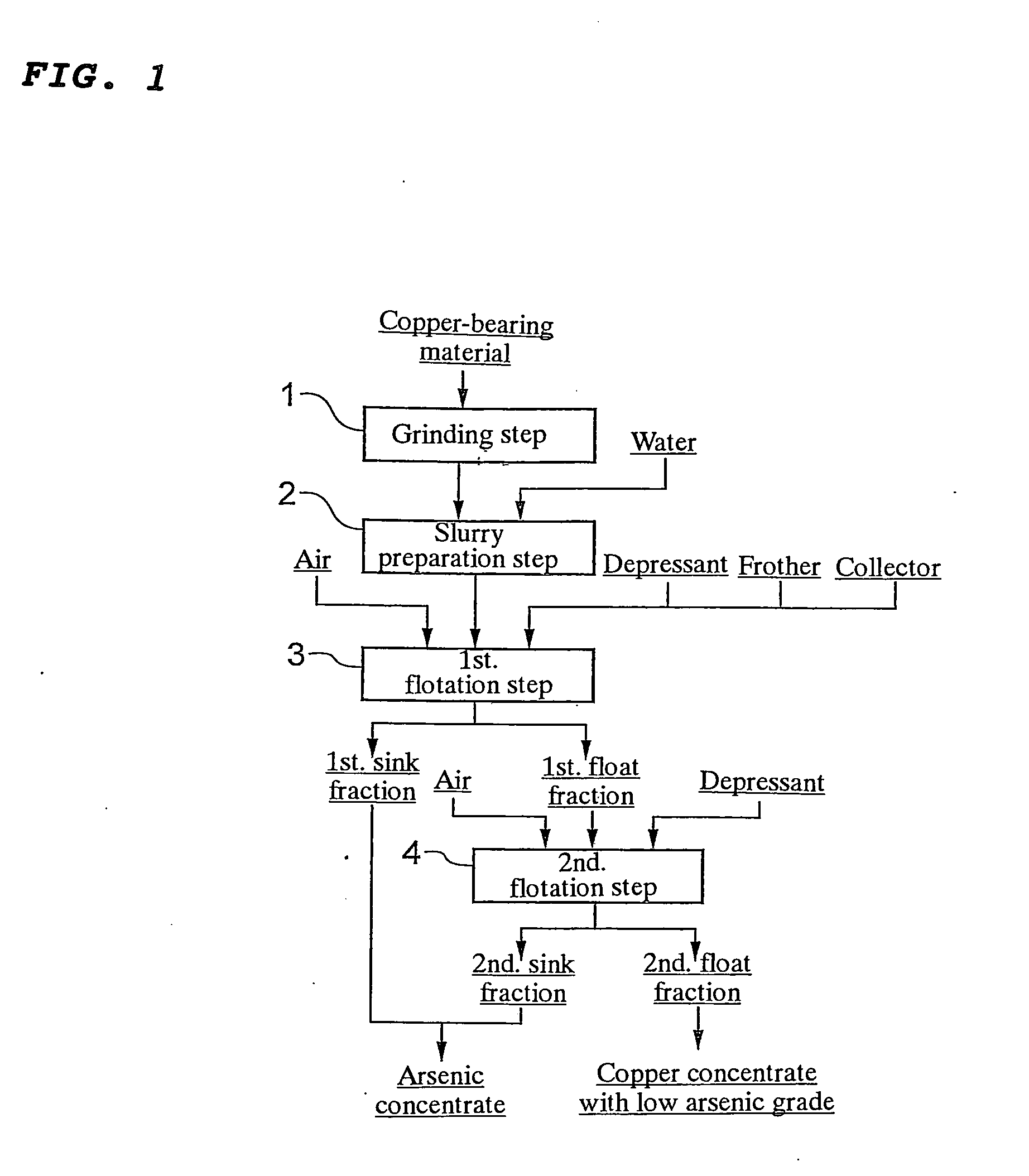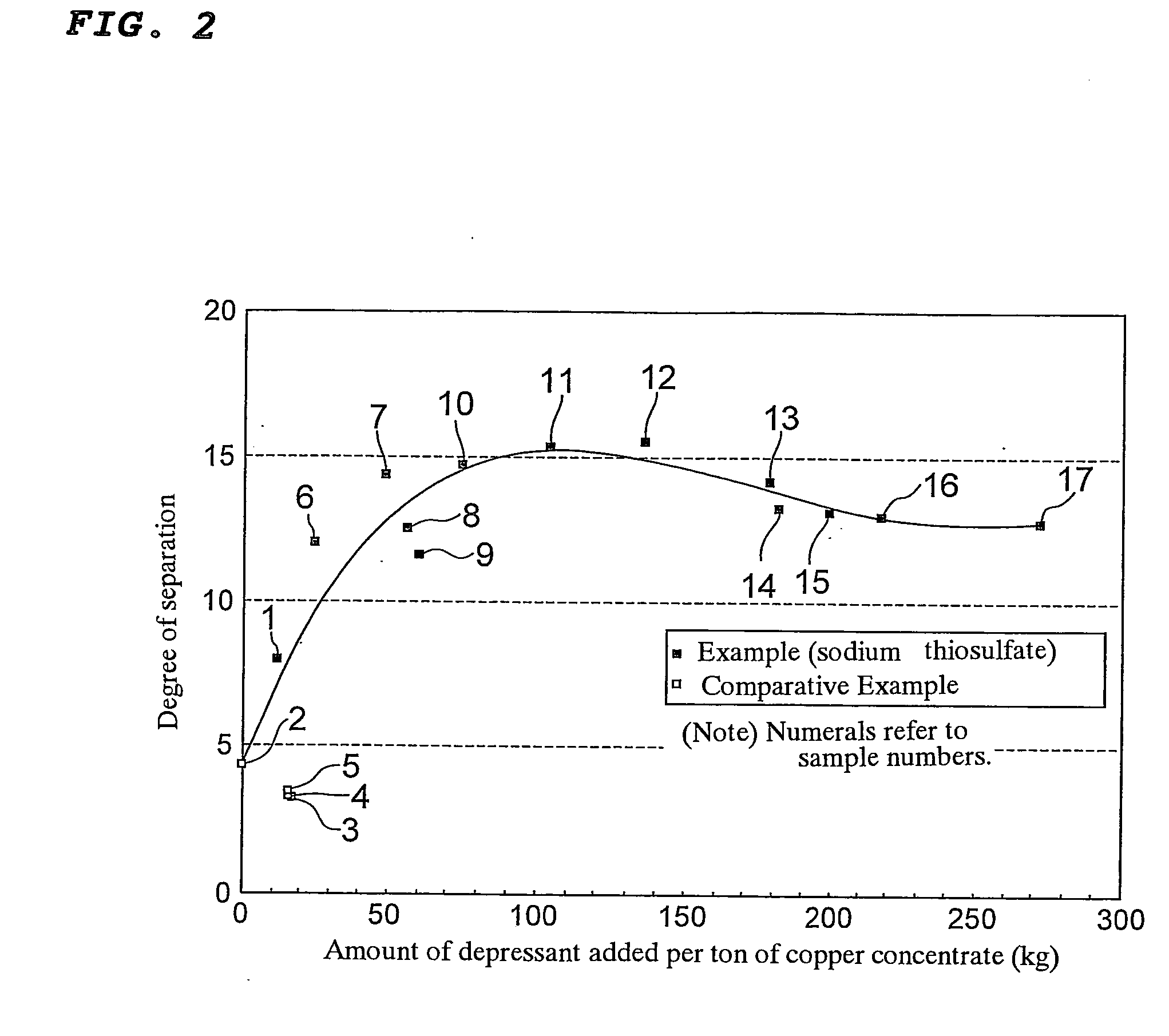Method for separating arsenic mineral from copper-bearing material with high arsenic grade
a technology of arsenic mineral and copper-bearing material, which is applied in the direction of flotation, centrifuges, chemistry apparatus and processes, etc., can solve the problems of increasing the cost of arsenic fixation, increasing the amount of arsenic fixed in slag, and requiring significant investment, so as to achieve high arsenic grade, low arsenic grade, and efficient copper concentrate
- Summary
- Abstract
- Description
- Claims
- Application Information
AI Technical Summary
Benefits of technology
Problems solved by technology
Method used
Image
Examples
example 1
[0039]In Example 1, a copper concentrate from Peru was used as a copper-bearing material. The chemical analytical values and mineral composition of the copper concentrate are shown in Table 1.
TABLE 1Chemicalanalyticalvalue (wt %)Mineral composition (wt %)CuAsChalcopyriteChalcociteTennantite22.31.0657.00.26.6
[0040]The copper concentrate from Peru shown in the above Table 1 was subjected to flotation in accordance with the flow chart shown in FIG. 1 to obtain a copper concentrate with low arsenic grade and an arsenic concentrate. More specifically, the copper concentrate from Peru was ground by a ball mill so that a 80% passing particle size of 15 μm was achieved (grinding step 1). Then, 25 g of the ground copper concentrate was mixed with 400 mL of water and stirred for 3 minutes to prepare a slurry (slurry preparation step 2). The slurry was placed in an Agitair laboratory flotation machine having a cell volume of 0.5 L.
[0041]Then, sodium thiosulfate was added as a depressant for de...
example 2
[0053]Copper concentrates with low arsenic grade and arsenic concentrates of Samples 6 to 17 were obtained in the same manner as in the case of obtaining Sample 1 except that the total amount of sodium thiosulfate added per ton of copper concentrate to be subjected to flotation was changed to a value within the range of 25 to 271 kg. It is to be noted that in all the cases of Samples 6 to 17, the amount of sodium thiosulfate added in the second flotation step 4 was 2 kg / t. The copper grade and arsenic grade of the copper concentrate with low arsenic grade and those of the arsenic concentrate were determined for each of Samples 6 to 17. Further, the ratio of distribution of copper to the copper concentrate with low arsenic grade and that to the arsenic concentrate were determined for each of Samples 6 to 17. Similarly, the ratio of distribution of arsenic to the copper concentrate with low arsenic grade and that to the arsenic concentrate were determined for each of Samples 6 to 17. ...
example 3
[0055]A copper concentrate from Peru was used as a copper-bearing material. The chemical analytical values and mineral composition of the copper concentrate are shown in the following Table 4.
TABLE 4Chemicalanalyticalvalue (wt %)Mineral composition (wt %)CuAsChalcopyriteChalcociteTennantite26.60.1579.12.11.3
[0056]The copper concentrate from Peru shown in the above Table 4 was subjected to flotation in accordance with the flow chart shown in FIG. 3 to obtain a copper concentrate with low arsenic grade and an arsenic concentrate. More specifically, the copper concentrate from Peru shown in the above Table 4 was ground by a ball mill so that a 80% passing particle size of 15 μm was achieved (grinding step 11). Then, 100 g of the ground copper concentrate was sampled, mixed with 400 mL of water, and then stirred for 3 minutes to prepare a slurry (slurry preparation step 12). The slurry was placed in an Agitair laboratory flotation machine having a cell volume of 0.5 L.
[0057]Then, sodium...
PUM
| Property | Measurement | Unit |
|---|---|---|
| Weight | aaaaa | aaaaa |
| Weight | aaaaa | aaaaa |
| Reduction potential | aaaaa | aaaaa |
Abstract
Description
Claims
Application Information
 Login to View More
Login to View More - R&D
- Intellectual Property
- Life Sciences
- Materials
- Tech Scout
- Unparalleled Data Quality
- Higher Quality Content
- 60% Fewer Hallucinations
Browse by: Latest US Patents, China's latest patents, Technical Efficacy Thesaurus, Application Domain, Technology Topic, Popular Technical Reports.
© 2025 PatSnap. All rights reserved.Legal|Privacy policy|Modern Slavery Act Transparency Statement|Sitemap|About US| Contact US: help@patsnap.com



